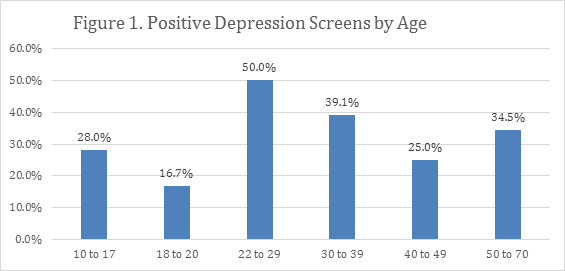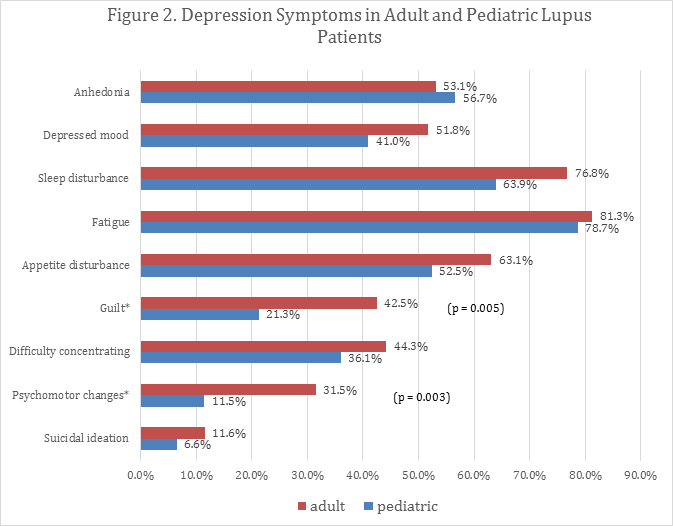Session Information
Date: Wednesday, November 16, 2016
Title: Systemic Lupus Erythematosus – Clinical Aspects and Treatment VI: Quality of Life
Session Type: ACR Concurrent Abstract Session
Session Time: 11:00AM-12:30PM
Background/Purpose: Depression is commonly seen in lupus, but widely varying prevalence rates have been reported. This may be due to different demographics and characteristics or varying detection methods across studies. Furthermore, few studies have looked at depression prevalence in lupus patient cohorts inclusive of both children and adults. Better describing the frequency of symptoms of depression in a lupus population at high risk for depression may help identify target populations for screening, treatment, and possible prevention.
Methods: Lupus patients at three affiliated hospitals, regardless of age, who met ACR criteria were enrolled in the Einstein Lupus Cohort. Patients enrolled in the cohort who agreed to depression screening, were given the Patient Health Questionnaire-9 (PHQ9), and extensive clinical and epidemiological data was recorded. Differences in prevalence rates were investigated across age groups using a chi-square analysis. Differences between pediatric and adult patients were examined in relation to depression symptoms and clinical and demographic characteristics by chi-square and Mann-Whitney U tests. Logistic regression was used to identify potential predictors for depression in the cohort.
Results: The median age was 28.4 (IQR 19.5, 45.3) for 175 screened patients; 47.7% were black, 45.5% Hispanic, and 6.9% other; 82% were Medicaid-enrolled; 31.4% had positive PHQ9 screens. Pediatric patients were similar to adult patients in most demographics and clinical characteristics, but had lower rate of comorbid chronic pain syndromes and previously diagnosed psychiatric disease. There was no linear correlation between age and depression, but a peak in prevalence of 50% was seen among patients 22-29 years old compared to a relatively low rate of 16.7% among 18-21 year olds (Fig. 1). Pediatric patients reported statistically significant lower rates of guilt and psychomotor changes, while rates of other endorsed depression symptoms were similar (Fig. 2). There were no significant predictors found for depression in the cohort, including steroid dose and disease activity measured by SLEDAI.
Conclusion: Younger patients with lupus have different depression symptoms than adults. A very high rate of depression was seen in young adult patients from our cohort, especially compared to patients immediately preceding them in age. Our observations have important implications for transitioning processes for teenage lupus patients, and may indicate the need to target adolescence for preventative measures to help minimize the substantial disease burden of depression that may occur in subsequent years.
To cite this abstract in AMA style:
Rubinstein T, Schwartz N, Jordan N, Lois R, Wahezi D, Stein REK, Putterman C. Depression Symptoms throughout the Lifespan in a Low-Income, Minority Cohort of Lupus Patients: Who Is at Risk? [abstract]. Arthritis Rheumatol. 2016; 68 (suppl 10). https://acrabstracts.org/abstract/depression-symptoms-throughout-the-lifespan-in-a-low-income-minority-cohort-of-lupus-patients-who-is-at-risk/. Accessed .« Back to 2016 ACR/ARHP Annual Meeting
ACR Meeting Abstracts - https://acrabstracts.org/abstract/depression-symptoms-throughout-the-lifespan-in-a-low-income-minority-cohort-of-lupus-patients-who-is-at-risk/


